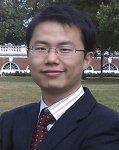Program Information
Towards Integrated CT and Ultrasound Guided Radiation Therapy Using A Robotic Arm with Virtual Springs
K Ding*, Y Zhang , H Sen , M Lediju Bell , S Goldstein , P Kazanzides , I Iordachita , J Wong , Johns Hopkins University, Baltimore, MD
Presentations
SU-E-J-114 Sunday 3:00PM - 6:00PM Room: Exhibit HallPurpose: Currently there is an urgent need in Radiation Therapy for noninvasive and nonionizing soft tissue target guidance such as localization before treatment and continuous monitoring during treatment. Ultrasound is a portable, low cost option that can be easily integrated with the LINAC room. We are developing a cooperatively controlled robot arm that has high intrafraction reproducibility with repositioning of the ultrasound probe. In this study, we introduce virtual springs (VS) to assist with interfraction probe repositioning and we compare the soft tissue deformation introduced by VS to the deformation that would exist without them.
Methods: Three metal markers were surgically implanted in the kidney of one dog. The dog was anesthetized and immobilized supine in an alpha cradle. The reference ultrasound probe position and force to ideally visualize the kidney was defined by an experienced ultrasonographer using the Clarity ultrasound system and robot sensor. For each interfraction study, the dog was removed from the cradle and re-setup based on CBCT with bony anatomy alignment to mimic regular patient setup. The ultrasound probe was automatically returned to the reference position using the robot. To accommodate the soft tissue anatomy changes between each setup the operator used the VS feature to adjust the probe and obtain an ultrasound image that matched the reference image. CBCT images were acquired and each interfraction marker location was compared with the first interfraction result.
Results: Analysis of the marker positions revealed that the kidney was displaced by 18.8 ± 6.4 mm without VS and 19.9 ± 10.5 mm with VS. No statistically significant differences were found between two procedures.
Conclusion: The VS feature is necessary to obtain matching ultrasound images, and they do not introduce further changes to the tissue deformation. Future work will focus on automatic VS based on ultrasound feedback.
Funding Support, Disclosures, and Conflict of Interest: Supported in part by: NCI R01 CA161613; Elekta Sponsored Research
Contact Email:


